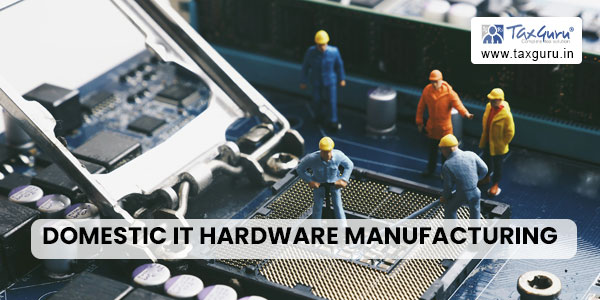Introduction:
The Indian government recognizes the crucial role of the electronics industry in the country’s economy. To attract investments and promote domestic manufacturing, the government has launched the Production Linked Incentive (PLI) 2.0 Scheme for IT Hardware. This scheme aims to provide financial incentives and create a favorable environment for the production of electronic goods, particularly in the IT hardware sector.
Background behind Launch of PLI 2.0 Scheme for IT Hardware Manufacturing:
The demand for electronic goods in India has been steadily rising, with the domestic production increasing from ₹3,17,331 crore (USD 49 billion) in 2016-17 to ₹6,40,810 crore (USD 87.1 billion) in 2021-22. However, India’s share in global electronics manufacturing is still relatively low at 3.75% in FY 2021-22. To reduce the reliance on imports and boost domestic production, the government aims to increase manufacturing capabilities in the IT hardware sector.
Objective of PLI 2.0 Scheme for IT Hardware Manufacturing:
The primary objective of the PLI 2.0 Scheme for IT Hardware is to incentivize and promote domestic manufacturing by attracting large investments in the value chain. By providing financial incentives, the government aims to encourage the localization of IT hardware components and sub-assemblies, leading to increased production within the country.
Quantum of Benefit under PLI 2.0 Scheme for IT Hardware Manufacturing:
Under the scheme, an average incentive of approximately 5% will be offered for the localization of IT hardware items mentioned in Annexure-B. The initial focus will be on localizing Printed Circuit Board Assembly (PCBA) and Assembly, with the requirement to add at least one component or sub-assembly each year from the optional list. Special emphasis has been placed on incentivizing the manufacturing of semiconductors, as they are vital components in most target segments. The incentives offered will gradually decrease over the years as outlined in Annexure-B.
Target Segment:
The PLI 2.0 Scheme for IT Hardware covers several target segments, including:
1. Laptops
2. Tablets
3. All-in-One PCs
4. Servers
5. Ultra Small Form Factor (USFF) devices

Beneficiaries of PLI 2.0 Scheme for IT Hardware Manufacturing:
The scheme aims to benefit domestic manufacturers, investors, and the overall economy. By incentivizing domestic manufacturing, the government seeks to create employment opportunities, reduce import dependency, and position India as a global hub for IT hardware production.
Eligibility for PLI 2.0 Scheme for IT Hardware Manufacturing:
The eligibility criteria for the PLI 2.0 Scheme for IT Hardware are as follows:
- The scheme is open to global and domestic companies manufacturing IT hardware in India.
- Applicants will be ranked based on eligibility criteria in the scheme guidelines.
- Selection will be based on ranking and projected PLI, subject to budget availability.
- Each applicant can submit only one application.
- Existing PLI Scheme applicants can participate as new entrants if they haven’t claimed incentives.
- Existing applicants wanting to claim incentives can participate in the next year if selected.
- Eligibility is based on incremental investment and net sales thresholds (refer Annexure-A to the scheme).
- Investment in contract manufacturing facilities counts towards the applicant’s investment.
- Incremental investment by component/sub-assembly manufacturers can also be counted.
- Shortfalls in investment result in a proportional reduction in PLI, up to 40%.
- Estimated PLI amounts are based on incremental sales and localization plans.
- Firmware for servers must be sourced from Indian or trusted foreign sources certified by MeitY.
- Eligibility under PLI 2.0 does not affect eligibility under other schemes.
PLI 2.0 Scheme Tenure:
The PLI 2.0 Scheme will be available for a period of six (6) years. The initial application period will be forty-five (45) days, with the possibility of extension. The scheme may be reopened for applications at any time during its tenure based on industry response. Applicants who apply after the initial period will be eligible for incentives for the remaining tenure, ending on 31.03.2031.
Base Year:
The base year for calculating net incremental sales of manufactured goods is FY 2022-23. Applicants can choose to participate from 1.04.2024 or 1.04.2025, in which case FY 2023-24 or FY 2024-25 will be the base year. FY 2021-22 will be considered for qualification criteria regardless of the participation year.
Incentive Outlay:
The expected cumulative incentive outlay for the PLI 2.0 Scheme is as follows:
- Incentives will be applicable for 6 years, starting from July 1, 2023, April 1, 2024, or April 1, 2025, depending on the applicant’s choice.
- Incentives per company will be based on net incremental sales, with ceilings of ₹4,500 Crore for Global companies, ₹2,250 Crore for Hybrid (Global/Domestic) companies, and ₹500 Crore for Domestic companies.
- A penalty of 5% or 10% will be imposed on the payable PLI amount if the actual PLI falls short by 25%-50% or more than 50%, respectively, compared to the estimated PLI provided by the applicant.
Computation and Approval:
Incremental investment and net sales will be assessed based on applicant-provided details. Applications must be submitted before the due date, and approvals will be issued to eligible applicants based on qualification criteria and budget availability. Incentives will be released to eligible applicants upon meeting eligibility thresholds and fulfilling disbursement requirements.
Nodal Agency and Empowered Group of Secretaries (EGoS):
The PLI 2.0 Scheme will be implemented through a Nodal Agency, with specific responsibilities outlined in the scheme guidelines. The Empowered Group of Secretaries will monitor and review the scheme’s progress and may make revisions and amendments as necessary during the scheme’s tenure.
PLI 2.0 Scheme Guidelines and Amendments:
The Ministry of Electronics and Information Technology will issue separate guidelines for the PLI 2.0 Scheme with the approval of the Minister of Electronics and Information Technology. The scheme and guidelines will be periodically reviewed and amended as required with the approval of the Minister of Electronics and Information Technology.
Source: Ministry of Electronics and Information Technology (IPHW Division) Notification, New Delhi, the 29th May, 2023
*****
For more information on the subject the author can be contacted at anshul@rsalegalsolutions.com





